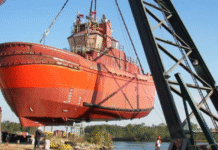Around 50,000 people forced into different livelihoods

A 50-square-kilometre area in Dakop upazila in Khulna that remained submerged in saline water for two years after cyclone Aila hit the region in 2009 has become an uncultivable and bleak place.
Fierce tidal surges cracked the embankments in the coastal southwestern region during the cyclone, driving saline water inward. Since then the water has kept on flooding the area twice a day during high tides.
The situation pushed around 50,000 people, mostly farmers living in 30 villages in Kamarkhola and Sutorkhali unions, to take refuge on embankments until 2011, when the government repaired the breaches and stopped saline water invasion.
A majority of the people returned to their villages and rebuilt their homes. But before they could resume their normal life, they found that the salinity had severely damaged the soil as well as surface and underground water tables. They could no longer cultivate any crops or plant trees on their land.
On a recent visit to villages in these two unions, this correspondent came across a bleak landscape dotted with a handful of palm, date and coconut trees. There was almost no cropland anywhere as far as the eye could see.
“Since there are not many trees around here, you cannot say from a distance if there is any wind blowing,” said Haraprasad Roy of Fakirdanga. He owns much cropland with zero harvest now.
Khorshed Alam, director of the Soil Resource and Development Institute, notes, “The soil of Dakop upazila had always been extremely saline [on a scale of five, it ranked 5]. But the salinity level drastically increased after Aila had brought in sea water, with farmland in many areas remaining inundated for long.”
Before the cyclone made a landfall, farmers could cultivate transplanted Aman during the rainy season. But nothing grows here any more after the cyclone.
The two unions are surrounded by the Vadra, Dhaki and Shibsa rivers, whose waters are also so saline that they cannot be used for irrigation or drinking.
The situation has pushed several thousand people into abandoning their ancestral land and looking for jobs in the towns and cities, locals say.
“Many people have lost their livelihood. Aila has ruined all scope of economic activities,” said Samoresh Roy, former chairman of Kamarkhola union.
The remaining farmers have become day labourers. Their family members spend a significant time looking for fresh water in the neighbourhood every day. While each household saves the rain water by whatever means possible, there are a number of ponds that serve as the major source of drinking water.
“Sometimes we have to buy drinking water at Tk 30 for a 20-litre jar from vendors coming by boat from Khulna,” said Shekhar, who hails from Kalinagar village in Kamarkhola.
Sushila Roy of Channir Chak village in Kamarkhola said she worked as a day labourer in a development project of a non-government organisation. Her husband Suvash used to be a farmer before Aila. But he too has been forced to turn a day labourer.
“We have two bighas of land completely ruined by salinity,” she said.
Against this backdrop, 250 families from Kamarkhola union and another 1,900 people of Sutorkhali who took refuge on the embankments in 2009 never returned home.
“These people are still living on the embankments because they do not have land to make their houses on,” said Uma Shankar Roy, chairman of Kamarkhola union.
The elderly woman Nashpati Roy lives on the embankment with her husband, a tuberculosis patient, her daughter and two grandsons. “My daughter and my grandsons are working as day labourers for survival,” she said.
Nashpati had a house on a 15-decimal plot of land in Jaulakhali village. After the cyclone, the Shibsa river devoured the house, she added.
Experts see little hope for a revival of traditional farming in the area. While shrimp farming could be one option, the land needs a regular pumping out of saline water, which poses risks to the embankments as the riverbeds have become higher than the farmlands due to siltation.
SRDI Director Khorshed Alam said the farmers could grow pumpkins, spinach [pui shak] and watermelons.
Prof Dr Ainun Nishat however said, “The salinity level of the soil would leach out in three to four years if there is adequate rainfall to wash up the land.
“Otherwise people can cultivate some saline tolerant variety crops like sunflowers, maize or watermelons,” added Dr Nishat, a leading hydro-expert of the country and vice-chancellor of BRAC University.
Aila had damaged about 2 lakh acres of cropland, affecting the food security of the area. The SRDI is now conducting a fresh survey to determine if the situation caused by soil salinity has improved at all.
Source: The Daily Star









